Omnivores of Belize
This is a sampling of the most common land dwelling Mammalian Omnivores that are found in
Belize.
Also on this page are the 3 Insectivores reliably reported in Belize, though the
anteaters are technically Xenarthrans.
Cacomistle - - - Bassariscus sumichrasti
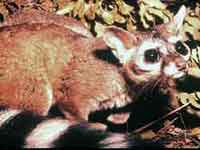
The cacomistle lives in the tropical evergreen rainforests and mountainous forests from southern Mexico to western Panama. It will seasonally migrate to the drier deciduous forests.
The cacomistle looks similar to the closely related ring tailed cat. The color of their pelage is grayish to brownish grey, and their tail has rings of black and buff color. They can be distinguished from the ring-tailed cat by their more pointed ears, non-retractable claws, naked soles, longer tail, and the lower ridges on their molars. They have 40 teeth.
The cacomistle is an omnivorous animal. They will feed on fruits like figs, papayas, and bananas and will also eat eggs, tree frogs, lizards, insects, birds, and mice.
Coatimundi - - - Nasua nasua

The Coatimundi is also know as Coati or quash. They have very strong claws for digging.
Coati live in dense forests, grasslands, and brushy areas from the southwestern United States through northern Argentina. Each band of females and young has a home area where it searches for food. Each male coati has his own territory.
Coati feed on insects, snails, small reptiles, rodents, fruit and nuts.
Central American Wooly Opossum - - - Caluromys derbianus
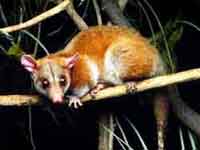
The wooly opossum inhabits both lowland and highland rainforests up to about 6500 feet. The common name of this opossum is derived from its wooly pelage. A dark strip is often present running from the crown to the fleshy portion of the nose. Pelage color shows much geographic variation. Its ears are creamy white to pink. All digits of the front and hind feet are clawed with the exception of the opposable hallux. The tail constitutes up to two-thirds of its total length. The latter half of the tail is naked and prehensile.
Little is known of the wooly opossums' behavior in nature. Captive animals showed a broad range of behavior initially, although any behavior was reduced dramatically once the animal was in captivity. In captivity the species is strictly nocturnal with greatest activity periods just before and after the light period.
Although food habits have not been investigated thoroughly, this opossum also appears to be omnivorous. Captive animals have eaten fruit, insects, and mice. They have been maintained on a laboratory diet of raw egg, fruit, and dog food.
Grey Four-eyed Opossum - - - Philander Didelphidae
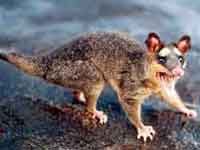
The Gray Four-eyed Opossum Can be found throughout Central and South America.
The species has a sharply defined white spot above each eye and, also, a bicolored tail, with a white distal part and a longer proximal darker one. It's a solitary arboreal animal found in moist areas, although it wanders in many different vegetation types.
Gray Four-eyed Opossums do not have a well defined territory, and home range stability depends on the availability of adequate resources. They feed basically on small animals and secondarily on fruits.
Kinkajou - - - Potos flavus

The kinkajou, known as the "night walker" in Belize, is a nocturnal animal which lives among the upper canopy of the tropical forest. They range from Southern Mexico to Southern Brazil. They are found in a variety of habitats, from mature tropical forests to heavily disturbed and secondary forests. The kinkajou is one of the most commonly seen animals of the tropical forest.
The kinkajou is extremely agile and fast, traveling quickly along the tree tops, jumping noisily from tree to tree. The long prehensile tail is used to balance and hold on while traveling among the tree tops.
They feed mainly on fruit and insects. In the dry season of Belize, they often eat flowers for their nectar.
Spider Monkey - - - Ateles geoffroyi
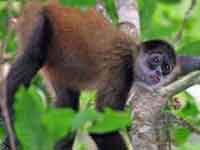
Spider monkeys inhabit the tropical rain forest of southern Mexico, Central and South America. Characterized by their long, slender limbs and great agility Spider Monkeys have long prehensile tails, the longest and most powerful of all primates. The fur is gray to brown or black, with lighter undersides; the face has white eye rings and is shaded by projecting hair that is either light or dark in color. Their hands lack thumbs.
They travel in small bands in forest trees, moving swiftly by making tremendous leaps, sprawling out like spiders, and grasping tree limbs with their prehensile tails. Spider monkeys use specific routes as they travel through the trees. These routes remain constant. They forage in groups ranging from one to twenty individuals. The groups are constantly changing as individuals come and go. This gives the group the appearance of being unstructured but these fluid groups are actually subgroups of a larger permanent group.
Spider monkeys live high in the trees of the rain forest, feeding mainly ripe friut and less frequently leaves and flowers. They may also eat some nuts, seeds, insects, arachnids, and eggs.
They rarely descend to the jungle floor mainly.
Virginia opossum - Didelphis Virginiana

The Virginia Opossum inhabits the United States east of the Rocky Mountains, and along the coast west of the Rockies from British Columbia, Canada into Mexico and Central America as far south as Costa Rica. The Virginia opossum is solitary and nocturnal. It is both arboreal and terrestrial, and builds its nest out of leaves packed into tree hollows.
This opossum is about the size of a house cat, with short legs, an opposable, clawless big toe, and a long flattened, pointed nose. It has small, thin, hairless ears and a long, nearly naked, scaly prehensile tail. Its fur is long and gray or brown, with numerous white guard hairs throughout.
This animal can be a very fierce fighter, for its size. This can startle many carnivores into looking for a meal elsewhere. But in the event that the possum runs into a carnivore much larger, then it has the ability to play "dead." No matter what the attacker does, the possum just lies motionless. Playing "possum" like this does not always succeed, because a few carnivores enjoy carrion (food that is already dead).
The Virginia Opossum's diet consists primarily of fruit, insects, eggs, and small vertebrates.
Water Opossum - - - Chironectes minimus
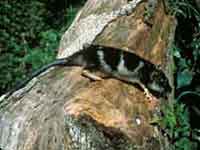
Water Opossum ranges from southern most Mexico through Central America, Colombia, Venezuela, Guianas, Ecuador, Peru, Paraguay, eastern Brazil, and northeastern Argentina. It is found in tropical and subtropical areas along fresh-water streams and lakes.
Individuals of this species are solitary and antisocial. They are sporadically active at night, showing no apparent circadian rhythm. Generally the water opossum lives in a subterranean den entered through an opening just above the water line of a stream bank. During the day they use an external ground nest made of grass or leaves. They gather nesting materials with their forefeet, push the grasses under their bodies, and grasp the load with their tails to transport it back to the den.
The Water Opossum eats primarily crayfish, shrimp, fish, frogs, and possibly aquatic vegetation and fruit. It propels its streamlined body through the water with its hind feet and uses its sensitive, tactile hands to catch its underwater prey.
Insectivores:
Least Shrew --- Cryptotis parva
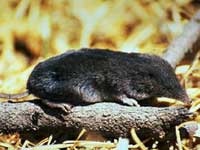
The Least Shrew has fur that is short, dense and velvety. In winter the upper fur is brown to black and the underside is white. In summer the fur is paler. Like many other shrews, the teeth have brown pigment on the cusps.
Unlike most shrews, Least Shrews seems to be somewhat social. Nests of as many as 31 individuals have been reported. Nests are small and are typically lined with loosely piled leaves. The nests are connected to the surface by runways or burrows.
Although individuals are active all day, activity peaks at night. Predators of Least Shrews include owls, red foxes, skunks, house cats, and snakes.
Another shrew, the Maya Small-eared Shrew (Cryptotis mayensis) is also found in Belize, but little information on its behavior is available.
The Silky Anteater - - - Cyclopes didactylus

Strictly insectivorous, the silky anteater feeds mostly on arboreal ants and termites. It will eat on an average 100 to 8000 ants per day. Considered an opportunistic feeder that forages among the treetops the anteater invades ants nest with it's long sticky tongue.
The silky anteater is nocturnal and almost never descends to the ground. Slow moving and not offensive in behavior, the anteater has formidable defense. When threaten the silky anteater stands on it's hind legs grasping the limbs of the tree with both it's prehensile tail and hind legs. Then holding it's forefeet close to it's face it's strikes with it's large sharp claws. They are very difficult to find in their natural habitat The silky anteater is arboreal and very rarely descends to the ground.
Tamandua - - - amandua tetradactyla
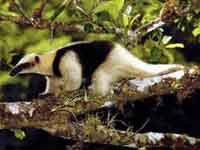
Tamanduas are found in Central and South America, from southeastern Mexico south throughout Central America, and in South America west of the Andes from northern Venezuela to northern Peru. They live in many different habitats from mature and secondary rainforests and plantations to gallery forests and arid savannas.
Tamanduas forage both on the ground and in the canopy of the forest. They are most commonly found beside streams and in trees with abundant vines and epiphytes. When they are not active, they rest in hollow trees, burrows of other animals, or natural shelters.
Tamanduas are mainly arboreal. They spend more than half their time in trees, however they move, feed, and rest on the ground as well. They cannot gallop on the ground, like giant anteaters, but can move on the ground with a stiff-legged, clumsy gait. They walk on the outside of their hands to avoid sticking their large claws into their palms. They are solitary animals that communicate by hissing sounds and a very potent odor produced from the anal gland. As a result, they are sometimes referred to as "stinker of the forest."
Tamanduas are specialized to eat termites and ants. Since they are mostly arboreal, they eat mostly ants and termites that nest in the trees. They detect their prey by scent. They have developed an aversion to leaf-eating ants, army ants, and other ants that produce chemical defenses. They also can tell the difference between different castes in the termite society. They will not eat soldiers of certain noxious termites, but will search out the defenseless workers of the same species and eat them.
